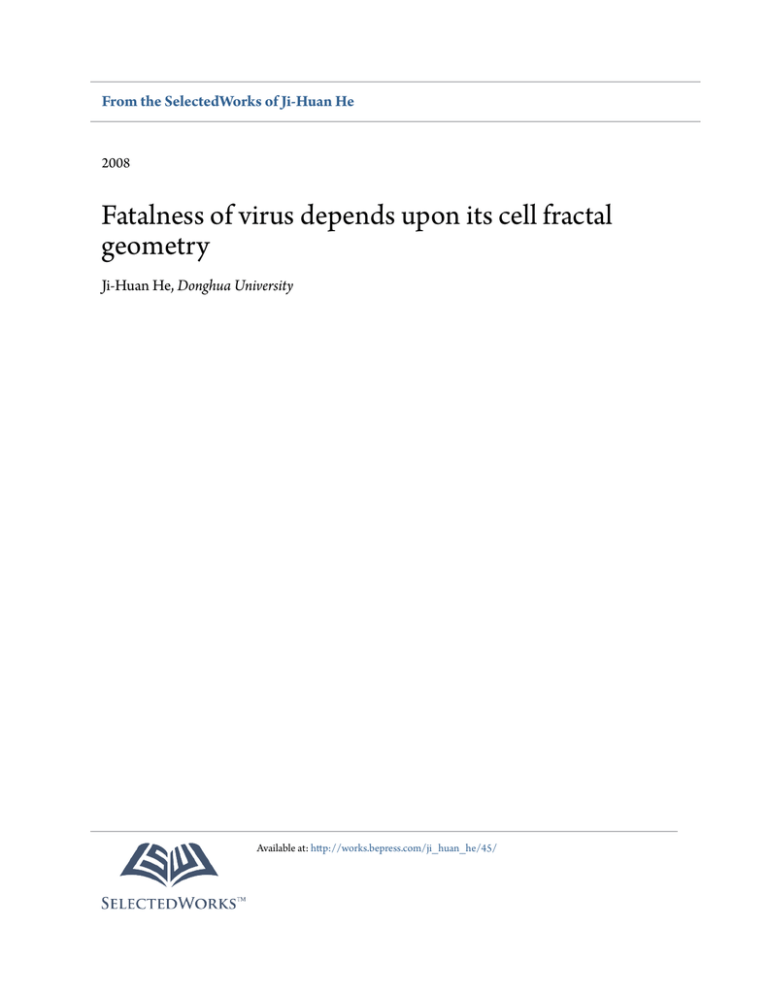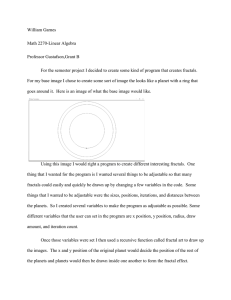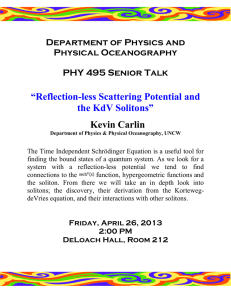
From the SelectedWorks of Ji-Huan He
2008
Fatalness of virus depends upon its cell fractal
geometry
Ji-Huan He, Donghua University
Available at: http://works.bepress.com/ji_huan_he/45/
Chaos, Solitons and Fractals 38 (2008) 1390–1393
Contents lists available at ScienceDirect
Chaos, Solitons and Fractals
journal homepage: www.elsevier.com/locate/chaos
Fatalness of virus depends upon its cell fractal geometry
Ji-Huan He
Modern Textile Institute, Donghua University, 1882 Yan’an Xilu Road, Shanghai 200051, China
a r t i c l e
i n f o
Available online xxxx
a b s t r a c t
Why do more complex viruses (e.g., HIV, AIDS-virus and SARS coronavirus) tend to be more
fatal? The paper concludes that the cell fractal geometry of viruses is the key. This paper
also suggests two possible new approaches using nanotechnology and temperature to cure
or prevent virus infection.
Ó 2008 Elsevier Ltd. All rights reserved.
1. Introduction
Just like human brain cells which have higher fractal dimension [1] than that of the general sphere cells, viruses are metabolically active having higher metabolic rate than the infected sphere cells due to their unsmooth surfaces having higher
fractal dimension.
For a single sphere cell, its metabolic rate, b, scales as follows [2,3]:
b / r2 ;
ð1Þ
where r is the radius of the cell. However, for a virus, its metabolic rate, bvirus , scales as follows:
bvirus / r Dvirus ;
ð2Þ
where rvirus is character radius of the virus, D is the fractal dimension of its surface, and it follows 2 < D < 3. Fig. 1 illustrates
various viruses’ surfaces.
Metabolic rate reflects both the ability of the organism’s transport system to deliver metabolites to the tissues and the
rate at which the tissues use them [4]. As it is well-known that four metabolically active organs, brain, liver, kidneys and
heart together account for 60% of energy expenditure in humans, even though the four organs represent <6% of body mass
[5].
When, e.g., an HIV virus, invades an organ, due to its higher fractal dimension of its surface, it can obtain enough energy
for reproduction. The procedure is slow but fatal.
2. Nanotechnology for virus prevention
There are many methods to explain various phenomena in biology, such as allometrical method [6,7], statistical method
[8] and E-infinity theory [9,10]. In particular, using a blend of the methodology of allometrical scaling and E-infinity theory it
was possible to solve various basic problems in biology [11]. Hereby we suggest a novel approach to prevent virus infection
by controlling the fractal dimension of virus’ surface using nanotechnology.
Electrospinning is now widely used to produce nanofibers [12–17]. Indigestible nano-scale drugs embedded in the digestible electrospun nanofibers should be used. The drugs cannot be absorbed by human cells, but can be absorbed by the unsmooth surface of viruses, making the virus surface smooth, as a result, the fractional dimension of the virus becomes
E-mail address: jhhe@dhu.edu.cn
0960-0779/$ - see front matter Ó 2008 Elsevier Ltd. All rights reserved.
doi:10.1016/j.chaos.2008.04.018
J.-H. He / Chaos, Solitons and Fractals 38 (2008) 1390–1393
1391
Fig. 1. Various viruses’ surfaces: (a) influenza virus; (b) HIV; (c) SARS coronavirus.
smaller up to 2, as illustrated in Fig. 2. The absorbed drugs on the virus’ surface also prevent the virus from obtaining enough
energy, leading to its final death.
When the metabolic rate of the viruses is not larger than the metabolic rate of its host body, the viruses become harmless
[18].
3. Improvement of the host’s metabolic rate
Another novel approach is to improve body temperature to improve metabolic rate of the infected man.
The scaling relationship between metabolic rate, B, and body mass, M, can be generally expressed as [19]
B / M ð4þ
3
Þ;
T30
40
ð3Þ
where T temperature in °C.
We suggests a modification of (3) in the form
B/M
3þ TT 0
4 4ð40T 0 Þ
;
ð4Þ
where T temperature in °C, T 0 is the body temperature.
The prediction (3) is valid within the limited range of ‘‘biologically relevant” temperatures between approximately 0 °C
and 40 °C. This is the range that organisms commonly operate within under natural conditions. Near 0 °C, metabolic reac-
1392
J.-H. He / Chaos, Solitons and Fractals 38 (2008) 1390–1393
Fig. 2. Nano-scale drugs absorbed on the surface of a virus.
tions cease due to the phase transition associated with freezing water, and above approximately 40 °C, metabolic reaction
rates reduced by the increasing influence of catabolism.
The life span L is predicted as
L / M ð1T=40Þ
ð5Þ
or
L/M
TT
144ð40T0
0Þ
:
ð6Þ
The increase of temperature leads to the increase of metabolic rate, decrease of life span [20,21], and also stimulates the immune response.
HIV rarely affects monkey, possible explanation is that the body temperature of, e.g., Japanese monkeys (Macaque Fuscata) is 38.6 °C, higher than human.
4. Conclusion
The idea proposed in this paper is simple enough, it provides an alternative way to preventing virus’ infection. The successful implementation of the proposed ideas gives a paradigm for preventing from virus infection.
Acknowledgements
The project is supported by National Natural Science Foundation of China under Grand No. 10772054 and the Program for
New Century Excellent Talents in University under Grand No. NCET-05-0417.
References
[1]
[2]
[3]
[4]
[5]
[6]
[7]
[8]
[9]
[10]
[11]
[12]
[13]
He JH, Zhang J. Fifth dimension of life and the 4/5 allometric scaling law for human brain. Cell Biol Int 2004;28:809–15.
He JH. An allometric scaling law between gray matter and white matter of cerebral cortex. Chaos, Solitons & Fractals 2006;27:864–7.
He JH, Huang ZD. A novel model for allometric scaling laws for different organs. Chaos, Solitons & Fractals 2006;27:1108–14.
Banavar JP, Damuth J, Maritan A, Rinaldo A. Supply–demand balance and metabolic scaling. Proc Natl Acad Sci (USA) 2002;99:10506–9.
Wang ZM, O’Connort TP, Heshka S, Heymsfield SB. The reconstruction of Kleiber’s law at organ-tissue level. J Nutr 2001;131:2967–70.
Kuikka JT. Fractal analysis of organ structure function and interactions. Int J Nonlinear Sci Numer Simul 2006;7:239–43.
West GB, Brown JH, Enquist BJ. A general model for origin of allometric scaling laws in biology. Science 1997;276:122–6.
Al-Suwaiyel MI, Alani A, Al-Swailem A. An investigation of Fibonacci-like sequences in biology and mathematics. Int J Nonlinear Sci Numer Simul
2006;7:133–6.
El Naschie MS. The brain and E-infinity. Int J Nonlinear Sci Numer Simul 2006;7:129–32.
El Naschie MS. A review of applications and results of E-infinity theory. Int J Nonlinear Sci Numer Simul 2007;8:11–20.
He JH. Application of E-infinity theory to biology. Chaos, Solitons & Fractals 2006;28:285–9.
He JH. Electrospinning: the big world of small fibers. Polym Int 2007;56:1321–2.
Xu L, He JH, Liu Y. Electrospun nanoporous spheres with Chinese drug. Int J Nonlinear Sci Numer Simul 2007;8:199–202.
J.-H. He / Chaos, Solitons and Fractals 38 (2008) 1390–1393
[14]
[15]
[16]
[17]
[18]
[19]
[20]
[21]
1393
He JH, Wan YQ, Xu L. Nano-effects quantum-like properties in electrospun nanofibers. Chaos, Solitons & Fractals 2007;33:26–37.
He JH, Liu Y, Xu L, et al. Micro sphere with nanoporosity by electrospinning. Chaos, Solitons & Fractals 2007;32:1096–100.
Liu Y, He JH. Bubble electrospinning for mass production of nanofibers. Int J Nonlinear Sci Numer Simul 2007;8:393–6.
He JH, Xu L, Wu Y, et al. Mathematical models for continuous electrospun nanofibers and electrospun nanoporous microspheres. Polym Int
2007;56:1323–9.
He JH, Mo LF, Xu L. On body size of infected mice. Acta Trop 2007;104:140–1.
Fan J, Liu JF, He JH. Hierarchy of wool fibers and fractal dimensions. Int J Nonlinear Sci Numer Simul 2008;9(3):293–6.
He JH. Shrinkage of body size of small insects: a possible link to global warming?. Chaos, Solitons & Fractals 2007;34:727–9.
He JH. Cell size and cell number as links between noncoding DNA and metabolic rate scaling. Chaos, Solitons & Fractals 2006;28:1026–8.


